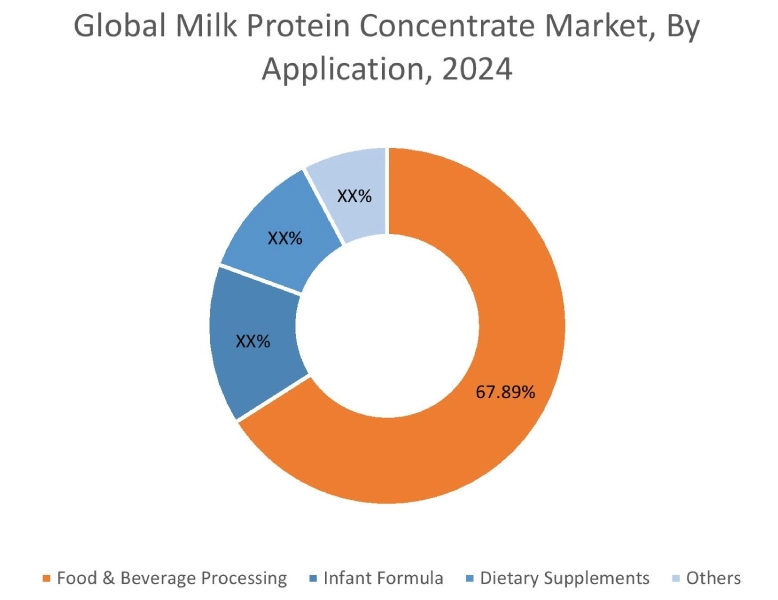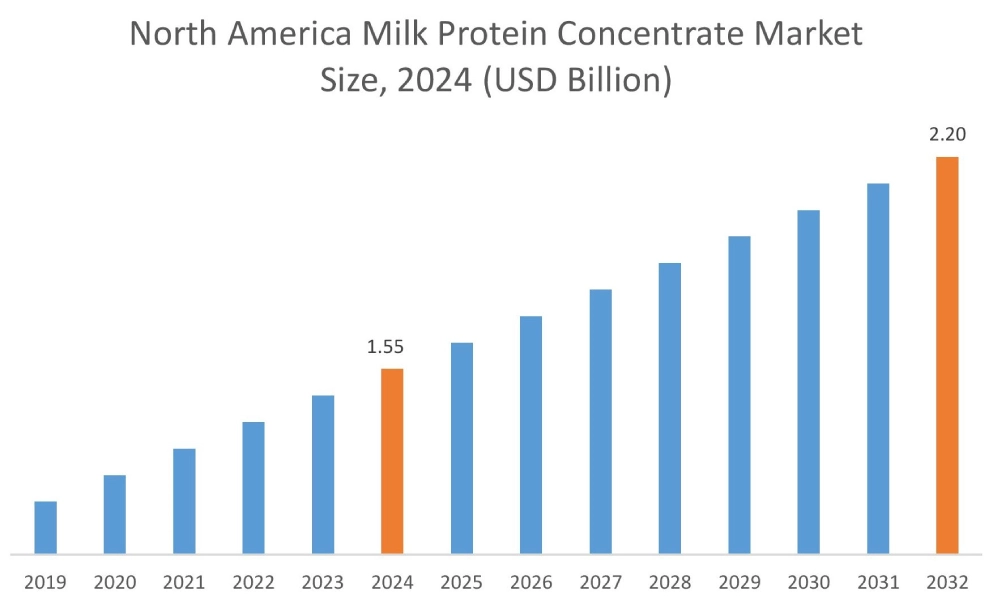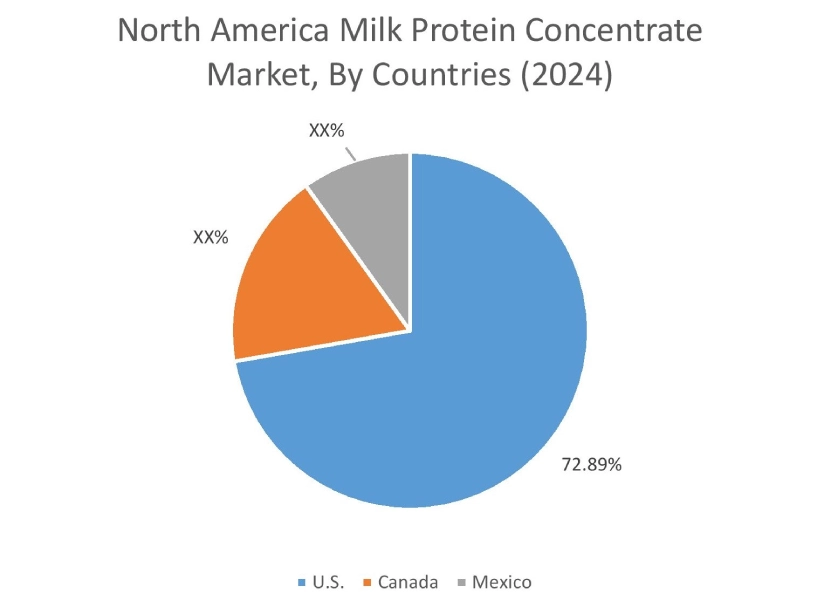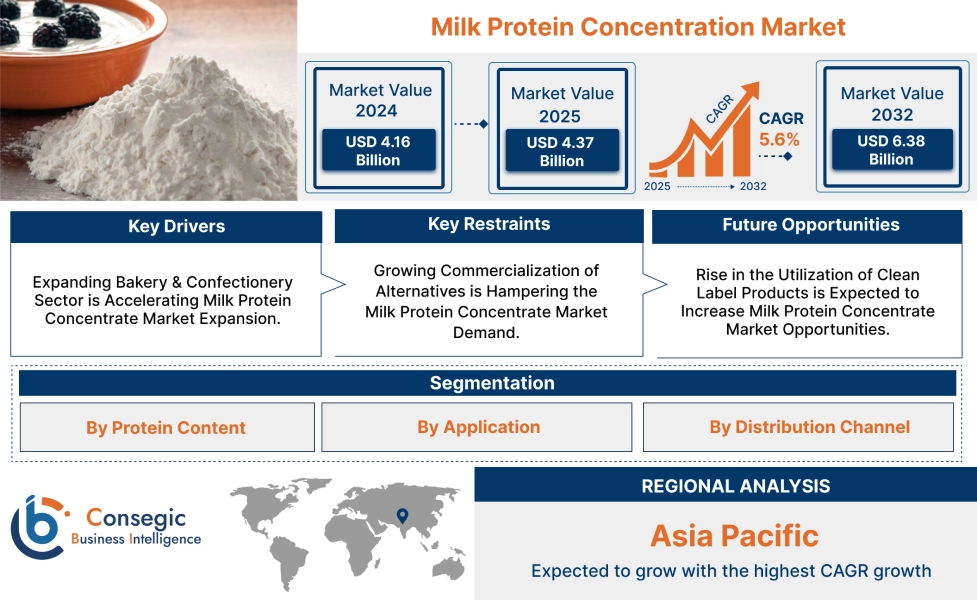How is AI Impacting the Milk Protein Concentration Market?
Artificial Intelligence is transforming the milk protein concentrate market by improving production efficiency, quality control, and product innovation. In manufacturing, AI-powered process monitoring systems analyze factors like temperature, flow rate, and concentration levels in real time, ensuring optimal protein yield and consistent quality. Machine learning models help predict equipment maintenance needs and reduce downtime, enhancing operational reliability. AI also assists in developing new formulations tailored to consumer preferences, such as high-protein or low-lactose variants. Furthermore, AI-driven demand forecasting and supply chain optimization enable better inventory management and reduced waste. Overall, AI is making milk protein concentrate production more efficient, sustainable, and responsive to evolving market and nutritional demands.
Milk Protein Concentration Market Dynamics - (DRO) :
Key Drivers:
Expanding Bakery & Confectionery Sector is Accelerating Milk Protein Concentrate Market Expansion.
Milk protein concentrate is used in bakery and confectionery to enhance various aspects of baked goods and sweets, including protein content, texture, and flavor. It helps in browning, acts as an emulsifier, increases viscosity, stabilizes foams, and improves mouthfeel. The rise in the consumption of bakery products is influencing the use of this concentrate.
For instance,
- Agriculture and Agri-Food Canada (AAFC) states that the baked goods retail sales in the United States (U.S.) increased at a CAGR of 5.9% over 2018 to 2022, thus positively impacting milk protein concentrate market trends.
Overall, the growing consumption of bakery & confectionery is significantly boosting the milk protein concentrate market expansion.
Rising Demand for High-Protein Products is Driving the Market.
The requirement for high protein products is growing mainly because of the rising awareness of overall health maintenance and convenience. Consumer interest in protein is being fueled by a desire for muscle development, weight management, and general health benefits. The protein content present in milk protein concentrate and high protein-to-lactose ratio make them a favorable choice for the development of products that have higher protein content. Consequently, manufacturers are developing new products to cater to this demand, thus driving market.
For instance,
- Valio introduced a new protein concentrate derived from milk, Valio Eila MPC 65, for better digestive comfort. This product enhances the properties of protein puddings, shakes, ice creams, and drinks, thus positively impacting the milk protein concentrate market trends.
Thus, the rising requirement for high protein products is accelerating the global milk protein concentrate market growth.

Key Restraints :
Growing Commercialization of Alternatives is Hampering the Milk Protein Concentrate Market Demand.
The market faces competition from other substitutes available in the market. The alternative material includes a range of plant-based proteins and other dairy derived proteins. These proteins provide similar benefits but different textures or flavors. The dairy derived protein such as whey protein concentrate is widely used to enhance the protein content and to help boost the muscle protein synthesis. The wide availability and cost effectiveness of whey protein concentrate makes it a significant alternative. Hence, the growing commercialization of substitutes is hampering the milk protein concentrate market demand.
Future Opportunities :
Rise in the Utilization of Clean Label Products is Expected to Increase Milk Protein Concentrate Market Opportunities.
The clean label trend is creating potential for the market, as consumers increasingly demand products with simple, natural ingredients that are easy to understand and free from artificial additives, preservatives and chemicals. Protein concentrate derived from milk align perfectly with this shift, as they are derived from natural dairy sources that mainly undergo minimal processing, making them highly suitable for clean label formulations. The rise in need for clean label products is influencing the use of these concentrations.
For instance,
- According to the data provided by Asia Food Journal in April 2024, it is stated that clean-label ingredients including natural ingredients are set to dominate portfolios in Europe within the next two years, making up over 70%, up from 52% in 2021.
Overall, a rise in the need for clean label products is expected to increase the milk protein concentrate market opportunities.
Milk Protein Concentration Market Segmental Analysis :
By Protein Content:
Based on protein content, the market is categorized into upto 70% and above 70%.
Trends in Protein Content:
- Below 70% is utilized more due to its cost-effectiveness and applicability in a wide array of food and beverage formulations.
- There is a growing preference for MPC with protein content above 70% in sports nutrition and dietary supplements.
The upto 70% segment accounted for the largest market share in 2024.
- Upto 70% of milk protein concentrate is usually called low-protein MPC. This includes types such as MPC 42, MPC 56, and MPC 70.
- Low-protein type is used in manufacturing yogurts, ice cream, cheese, milk, and baked goods. It is helpful in improving texture, add creaminess to these products, and increase protein content.
- The changing lifestyles requiring convenient and high protein foods have led to an increase in the food processing industry, thus driving the segment.
- For instance, according to Glanbia PLC, the yogurt market experiences growth, with sales increasing by 4.3% and volume expanding by 6.5% between 2021 and 2023.
- Overall, as per the market analysis, the rising need for convenient and high protein food is driving a segment in the milk protein concentrate market growth.
The above 70% segment is expected to grow at the fastest CAGR over the forecast period.
- Milk protein concentrates above 70% is called high-protein MPC. This includes MPC 75, MPC 80, and MPC 85.
- These are made by removing more water, lactose, and minerals from skimmed milk to keep protein content utmost.
- They are mostly used in sports drinks, protein powders, dietary supplements, meal replacements, and high-functional protein snacks.
- It is helpful in building muscle and also supports weight control. Moreover, it keeps an individual’s stomach full for longer time.
- Individuals are focusing more on health and fitness, which is leading them to use high-protein products like MPC, thus driving the segment.
- According to market analysis, growing focus on health and fitness will drive the segmental share for the upcoming years.
By Application:
Based on application, the market is categorized into food & beverage processing, infant formula, dietary supplements, and others.
Trends in the Application
- Protein concentrate derived from milk is increasingly used in protein bars, meal replacements, and weight management products due to its muscle-building properties.
- There is a growing trend of incorporating protein concentrate derived from milk in pet food and livestock feed formulations for high protein content.
The food & beverage processing segment accounted for the largest market share of 67.89% in 2024.
- The food & beverage processing segment is further categorized into dairy products, bakery & confectionery, functional foods, beverages, and others
- In dairy, it is used in yoghurt, cheese, and ice cream to make it creamier and higher in protein. In bakery and confectionery, it improves texture.
- Moreover, in functional food and beverage, it adds protein content without changing the taste.
- Additionally, it is helpful in holding moisture and keeping food soft and fresh for longer time. All these given advantages drive its demand in food and beverage processing.
- Overall, as per the milk protein concentrate market analysis, the milk protein’s ability to enhance the nutritional profile in a wide range of food & beverage products are driving the segment in the market.
The dietary supplements segment is expected to grow at the fastest CAGR over the forecast period.
- Protein concentrate derived from milk through ultrafiltration is widely used in dietary supplements because it contains both casein and whey, which help in muscle repair growth.
- It is also easy to digest and mix well in protein powders, meal replacements shake, and nutrition bars. It also supports people trying to lose weight.
- Increasing awareness of the role of nutrition in overall well-being is leading to increased demand for dietary supplements, thus driving the need for this concentrate.
- For instance, according to Indian Ministry of Food Processing, the dietary supplements market in India is expected to grow at CAGR of 17.1% between 2020 and 2026.
- Thus, according to market analysis, growing dietary supplements manufacturing will drive segment for the forecasted years.

By Distribution Channel :
Based on distribution channel, the market is categorized into offline and online.
Trends in the Distribution Channel
- Manufacturers are collaborating with specialized food ingredient distributors with established networks to reach a wider range of smaller food processors across various regions.
- Manufacturers are investing in their own online portals to facilitate direct inquiries, provide technical documentation, and potentially handle smaller sample orders or specific product lines.
The offline segment accounted for the largest market share in 2024.
- Offline distribution channels are further categorized into departmental stores, hypermarkets/supermarkets, specialty stores, and others.
- This channel provides direct engagement with suppliers to secure large-volume contracts. This ensures consistent supply chains and access to technical expertise.
- Moreover, buyers check product quality, negotiate prices, and get faster delivery through offline networks.
- Additionally, offline channels also help build stronger business relationships, which are important in the different industries such as food & beverage and nutraceuticals.
- The emphasis on quality assurance and personalized service is driving the segment.
- Overall, direct engagement, quality checks, and strong relationships is driving the segment in the milk protein concentrate industry.
The online segment is expected to grow at the fastest CAGR over the forecast period.
- Online channel is emerging in the market. This channel gives buyers benefits of placing orders anytime from anywhere. They also easily compare prices and read reviews, which help in purchasing decisions.
- Moreover, online stores offer more choices and special deals. It saves time and is more convenient for small businesses who need smaller amounts.
- Additionally, tracking orders and getting customer support is easier online. The use of the internet is growing, and more people are buying products online, thus driving segment.
- For instance, according to Oberlo, the US e-commerce sector is expected to grow at a CAGR of 8.7% from 2024 to 2028.
- Thus, according to market analysis, growing internet use fueling online shopping will drive segmental growth for the forecasted years.
Regional Analysis:
The regional segment includes North America, Europe, Asia Pacific, the Middle East and Africa, and Latin America.

Download Sample
In 2024, North America accounted for the highest milk protein concentrate market share at 37.31% and was valued at USD 1.55 Billion and is expected to reach USD 2.20 Billion in 2032. In North America, the U.S. accounted for the milk protein concentrate market share of 72.89% during the base year of 2024. The evolving consumer preferences, increasing urbanization, and rising disposable incomes has led to increase in consumption of dairy products and bakery/confectionery items in the region.
For instance,
- According to Farmonaut, in 2022, restaurants in Canada significantly increased their spending on baked goods, with purchases rising by 41% from previous year.

Download Sample
Protein concentrate derived from milk helps improve the texture, taste, and nutritional value of food. In dairy products such as yogurt, cheese, and milk drinks, it adds more protein and gives a creamy feel. In bakery and confectionery, it improves moisture, makes products softer, and helps them last longer.
In the Asia Pacific, the milk protein concentrate market is experiencing the fastest growth with a CAGR of 7.3% over the forecast period. There is increased adoption of infant formulas in the region. Many parents want high-quality, safe, and healthy food for their babies. Protein concentrate derived from milk is rich in protein, which helps in baby growth and development. It also has both chain and whey, just like real milk, making it a good match for infants. It is easy to digest and gives the formula a smooth texture and mild taste. As the number of working parents rises and urban families grow, more people are choosing ready-to-use infant formula, thus driving market in the region.
Europe's milk protein concentrate market analysis indicates that several key trends are contributing to its growth in the region. In the region, the requirements for clean label products are rising. Clean labels mean simple, natural ingredients without too many chemicals or additives. People in Europe are reading food labels more carefully and choosing healthy, clear, and trusted ingredients. Protein concentrate derived from milk fits well because it is a natural based protein with high nutrition and no strong taste. It is used in healthy snacks and protein foods.
Middle East and Africa (MEA) market analysis indicates that the use of dietary supplements is increasing. People are becoming more aware of health, fitness, and nutrition. Many are adding protein supplements to their daily routine to stay strong, fit, and active. Protein concentrate derived from milk is a good choice because it gives high-quality protein and is easy to mix in shakes, powders, and bars. Young people, gym users, and older adults are all using more supplements, thus driving in the region.
Latin America's region creates potential for the market. The use of functional foods and drinks is growing fast in the region. People want foods that not only taste good but also give health benefits such as more energy, stronger muscles, and better digestion. Protein concentrate derived from milk is rich in protein and is used in products such as yogurt, protein bars, milk drinks, and snacks. It helps improve nutrition, texture, and shelf life.
Top Key Players & Market Share Insights:
The Milk Protein Concentrate market is highly competitive with major players providing products to the national and international markets. Key players are adopting several strategies in research and development (R&D) and product innovation to hold a strong position in the global Milk Protein Concentrate market. Key players in The Milk Protein Concentrate industry include-
- Bioven Ingredients (India)
- Vitalus Nutrition Inc. (United States)
- Fonterra Co-Operative Group (New Zealand)
- Gay Lea Foods (Canada)
- Idaho Milk Products (United States)





